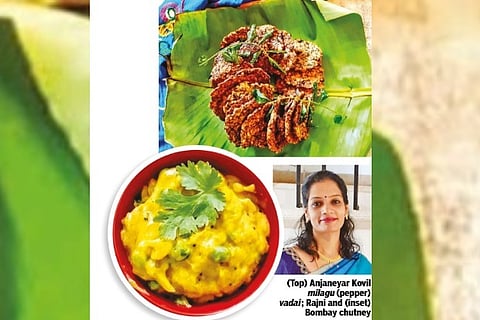

Chennai
Food is something everyone thinks from dawn to bedtime — be it a homemaker who has to plan the next meal or a globe-trotting executive.
The names of certain dishes caught the attention of food enthusiast and chef Rajni whose research on the history of dishes revealed some interesting trivia related to food.
“India has a rich food heritage, and as a foodie, I keep exploring it. There are folklores associated with some dishes. Intrigued by the concept, I started reading more about it, spoke to people, and gathered information. I am planning to do it as a series to create awareness about our food heritage,” says Rajni.
As the first step, she has explored the history behind three dishes — Bombay chutney, Anjaneyar Kovil milagu vadai, and mukkuruni kozhakattai. “Bombay chutney, a chickpea flour chutney, is a popular south Indian side dish. How then, does Bombay feature? This question confused me.
On researching, I found that it might be so because Maharashtra has its version of this chutney called pitla, which has a runnier consistency and different spices. I think this dish trickled down from Maharashtra to the south and got a makeover with different spices and Bombay chutney came to being.
Gujarat also has its version of this chutney, which is a slightly sweet version called kadi chutney, and so does the Andhra region, called senaga pindi pachadi.
“Anjaneyar Kovil milagu (pepper) vadai is another fascinating dish. This is offered as garland to deity in the count of 108/1008 in most Hanuman temples in south India. They have a longer shelf life than the regular vadai. Coming to why these vadais are specific to the Hanuman temple, mythology has it that, as a kid, Lord Hanuman did not allow Rahu (the one responsible for casting an eclipse as per Hindu mythology), to cast an eclipse while playing with the Sun. Pleased by this, Rahu gave a boon to Hanuman saying whoever worships Hanuman with urad and pepper vadais, will be relieved of any doshas (unfavorable conditions).” Rajni feels that every food lover must delve a little more than taste and presentation and find out the history behind the food.
“When I informed my father-in-law about the series that I am working on, he shared an interesting trivia behind the kozhakattai (modak) made as an offering to Lord Ganesha in the famous Madurai Meenakshi temple. It gets its name mukkuruni which means moondru (3) kurunni (a measure). So, three measures of flour are used to make one huge kozhakattai. on Ganesh Chaturthi day, Thereafter, it is cut and distributed as prasadam. Due to this, the Ganesha assumes the title of Mukkuruni Vinayagar,” concludes Rajni.
Visit news.dtnext.in to explore our interactive epaper!
Download the DT Next app for more exciting features!
Click here for iOS
Click here for Android